Surf fishing offers an exciting way to catch saltwater species from the shore, requiring minimal equipment and offering a rewarding experience for anglers of all skill levels.
What is Surf Fishing?
Surf fishing is a style of angling where anglers cast their lines into the ocean from the beach or shoreline. This method involves targeting fish that swim in shallow coastal waters. It is a simple yet effective way to catch species like bass, blues, and trout. Surf fishing is accessible to anglers of all skill levels, requiring basic gear and a understanding of coastal conditions. The sport combines patience, strategy, and a connection with nature, making it a popular choice for both beginners and experienced anglers alike. Its accessibility and variety of target species contribute to its widespread appeal worldwide.
Why Surf Fishing is Popular
Surf fishing is popular due to its accessibility, requiring minimal equipment and no boat, making it affordable and easy for anglers of all levels. The thrill of catching diverse species like bass and blues, combined with the connection to nature, adds to its appeal. Its strategic elements, such as reading the surf and understanding fish behavior, create a fulfilling experience. The strong community support and versatility of the sport further enhance its popularity, offering both solitude and social opportunities for anglers worldwide.
Surf Fishing Basics
Surf fishing involves catching fish in ocean waves from the beach, requiring a saltwater license, basic gear like rods and reels, and an understanding of tides and conditions.
Obtaining a Saltwater Fishing License
Before starting surf fishing, obtaining a saltwater fishing license is mandatory in most coastal states. Requirements vary by state, with options for resident or non-resident permits. Licenses ensure sustainable fishing practices and fund conservation efforts. Apply through local fish and wildlife agencies or authorized vendors. Maryland, Virginia, and North Carolina, for example, require licenses for beach fishing activities.
Essential Gear for Surf Fishing
A medium to heavy action rod and reel combo is ideal for surf fishing, offering the strength needed for larger species. Use live bait or artificial lures, depending on the target fish. Pyramid weights help cast farther, while hooks, swivels, and terminal tackle enhance presentations. Pliers or a net are handy for hook removal, and a tackle box keeps gear organized. Waders or boots can aid in navigating rocky or wet conditions.
Choosing the Right Bait and Lures
Choosing the right bait and lures is crucial for surf fishing success. Opt for natural baits like live bait or artificial lures, depending on the target species. Both can be effective, and understanding fish behavior helps in making the best choice.
Natural Baits for Surf Fishing
Natural baits like live bait or cut bait are highly effective for surf fishing; Fish such as mullet, shrimp, and squid are often used. Freshness is key, as it attracts fish more effectively. Using a cast net to catch live bait ensures freshness. This method is popular among experienced anglers for targeting species like bass and blues. It often outperforms artificial lures in specific conditions.
Artificial Lures and Their Effectiveness
Artificial lures are versatile and effective for surf fishing, mimicking the appearance and movement of prey. Spoons, jigs, and soft plastics are popular choices, often outperforming live bait in certain conditions. They allow anglers to target species like bass and blues with precision, making them a valuable addition to any surf fishing arsenal. Their convenience and durability enhance fishing success.
Reading the Surf
Reading the surf involves understanding wave patterns, currents, and structures to identify where fish are likely feeding. This skill enhances your ability to locate target species effectively.
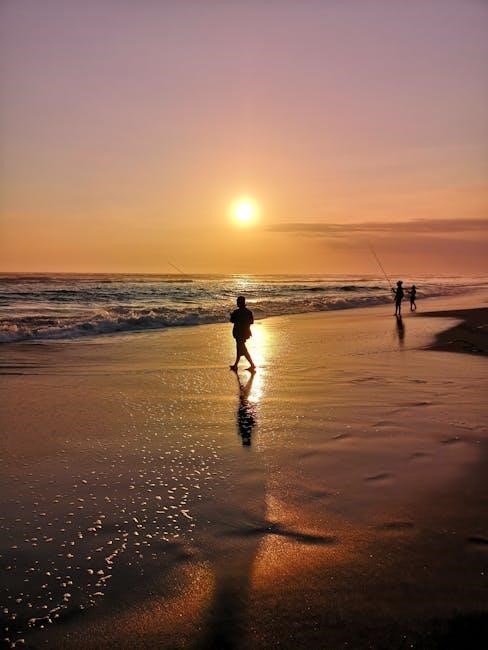
Identifying the Best Surf Fishing Spots
Identifying prime surf fishing spots involves looking for structures like sandbars, drop-offs, and estuaries where fish tend to congregate. Areas with baitfish activity or changing water depths are ideal. Timing your visit during low tide or dawn/dusk can reveal hidden features and improve your chances of locating active feeding zones for target species.
Understanding Fish Feeding Patterns
Understanding fish feeding patterns is key to successful surf fishing. Fish typically feed during changing tides, low light conditions, or when baitfish are present. Recognizing these patterns helps anglers identify active feeding zones and time their casts effectively, increasing the likelihood of a successful catch.
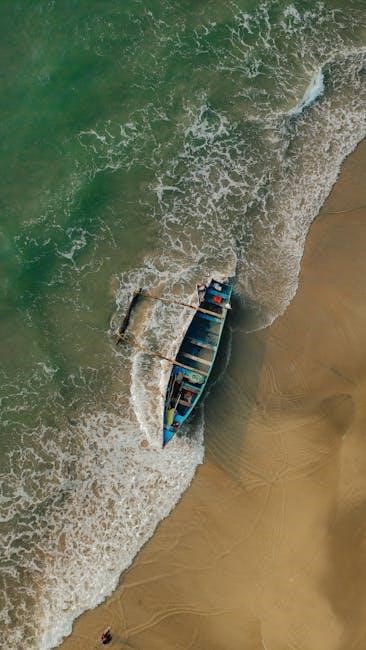
Casting Techniques
Casting techniques are essential for reaching target areas in surf fishing. Mastering the basic overhead cast ensures accurate and effective delivery of bait or lures.
Mastering the Basic Casting Motion
Mastering the basic casting motion is crucial for effective surf fishing. Start with a firm grip, feet shoulder-width apart, and align your body with the target. Snap your wrists to generate power, ensuring a smooth follow-through. Practice at low tide to refine accuracy. Begin with shorter casts to build control before extending your range. Consistency and patience are key to perfecting this fundamental skill.
Advanced Casting Techniques
Advanced casting techniques elevate your surf fishing game. Learn to use the environment to your advantage by casting into currents and reading wave patterns. Adjust your strength based on wind and water conditions. Practice long-distance and precision casting to target specific areas. These skills enhance accuracy and versatility, making you a more effective angler. Consistent practice is key to mastering these methods.

Fishing Timing and Conditions
Optimal timing for surf fishing includes dawn, dusk, and low tide. Favorable conditions involve overcast skies, moderate winds, and calm seas, enhancing fish activity and accessibility.
Optimal Times for Surf Fishing
The best times for surf fishing are during low light conditions, such as dawn and dusk, when fish are most active. High tide often brings fish closer to shore, while outgoing tides can create feeding opportunities in sandbars and sloughs. Overcast skies and moderate winds further enhance fish activity, making these conditions ideal for a productive fishing session.
Weather and Water Conditions
Weather and water conditions significantly impact surf fishing success. Overcast skies and moderate winds reduce fish spooking, while clear water increases visibility for both fish and anglers. Avoid rough seas and strong currents, as they make casting and holding position difficult. Water temperature fluctuations can affect fish activity, with warmer waters often attracting species like bass and blues. Tide changes also play a crucial role in fish movement and feeding behavior.
Fishing Etiquette
Respect the environment and fellow anglers by leaving no trash, minimizing noise, and giving others space. Always follow local regulations and practice catch-and-release carefully when appropriate.
Respecting the Environment
Always dispose of fishing gear and trash properly to protect marine life. Avoid damaging habitats and refrain from littering. Follow local regulations and be mindful of sensitive coastal ecosystems. By minimizing your impact, you help preserve the environment for future anglers and maintain the beauty of the beach for everyone to enjoy.
Coexisting with Other Anglers
Respect fellow anglers by maintaining a reasonable distance and keeping noise levels low. Avoid crowding popular spots and dispose of trash properly. Be patient and courteous, especially when others are casting or reeling in fish; Always follow local regulations and share tips or advice when appropriate to foster a positive fishing community and enjoyable experience for everyone.
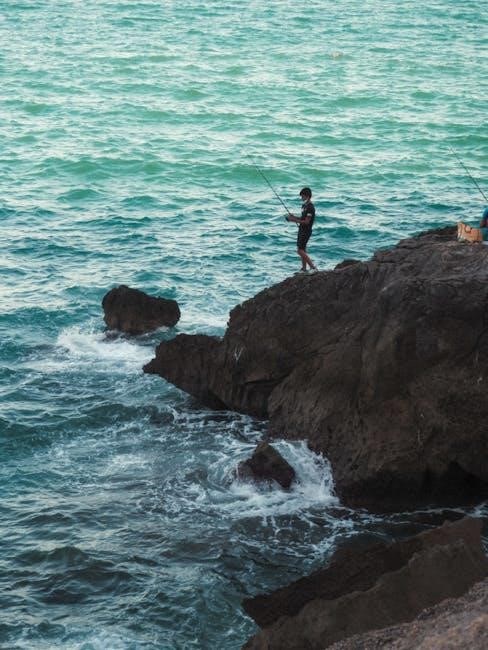
Targeting Specific Species
Understanding species behavior and bait preferences is key to successful surf fishing, allowing anglers to tailor strategies and increase chances of catching their desired fish effectively.
Common Surf Fishing Species
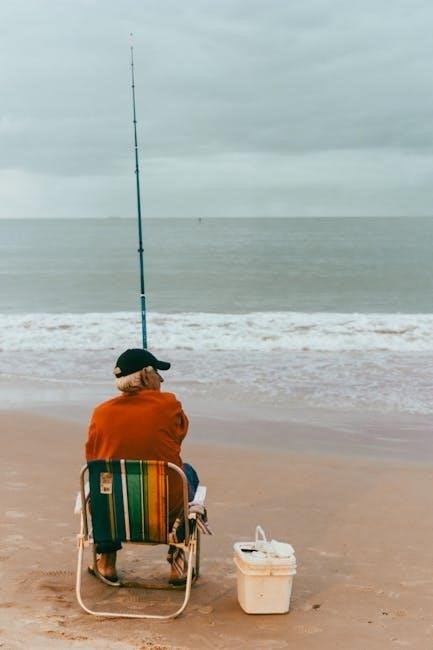
Popular species caught in surf fishing include striped bass, bluefish, and pompano. These fish are often found near sandy beaches and structure like reefs or jetties. Anglers may also encounter species like sharks, rays, and flounder depending on location and season. Understanding local fish populations helps anglers choose effective bait and lures for a successful day on the water.
Species-Specific Fishing Strategies
Targeting specific species requires tailored strategies. Striped bass respond well to live bait, while bluefish favor aggressive jigs. Pompano are drawn to small lures mimicking sand fleas. Sharks and rays often require cut bait and patience. Understanding each species’ feeding habits and habitats is key to success. Timing and location play crucial roles in effectively targeting your desired catch.
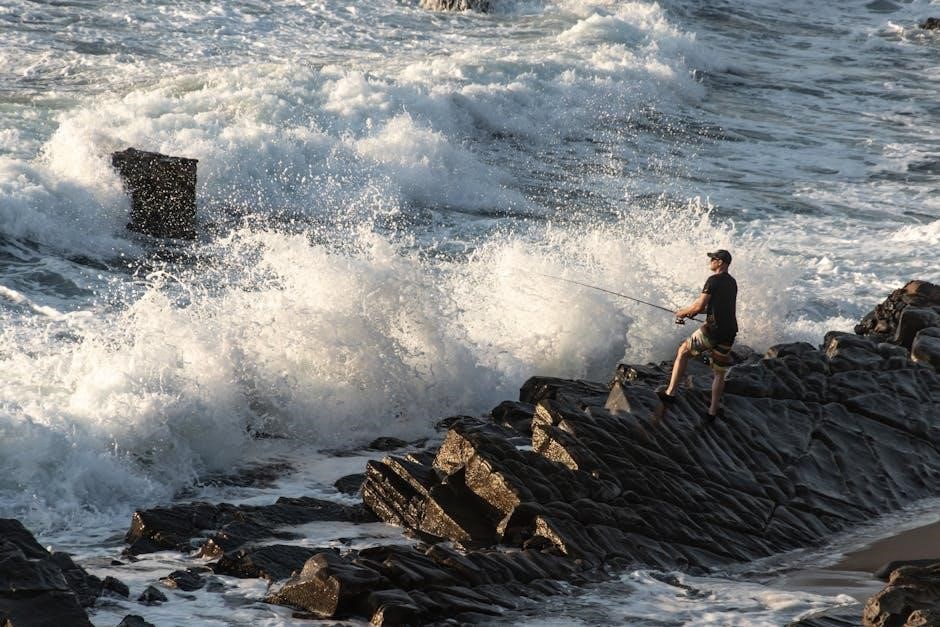
Advanced Tips and Tricks
Experiment with bait presentations, vary retrieval speeds, and adjust rigs based on conditions. Pay attention to tidal changes and moon phases to optimize your fishing success.
Tips for Consistent Catch
Focus on presentation and retrieval speed, as this can significantly impact fish attraction. Experiment with different bait types and rigs to match the target species. Pay attention to tidal patterns and fish behavior, adjusting your strategy accordingly. Observing and adapting to environmental changes will enhance your chances of a successful catch. Consistency often comes from patience and persistence in varying conditions.
Maintaining Gear and Improving Skills
Regularly clean and lubricate your rod and reel to ensure smooth operation. Store gear in a dry, cool place to prevent rust and damage. Practice casting techniques to improve accuracy and distance. Study fish behavior and adapt your strategies to different conditions. Stay updated on the latest tackle and methods to enhance your surfing fishing effectiveness and success over time.